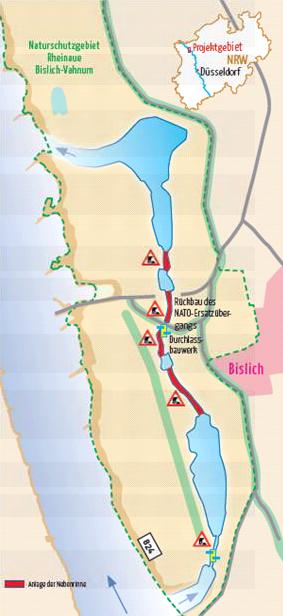Rhine - Nebenrinne Bislich-Vahnum (LIFE08 NAT/D/000007)
Rhine - Nebenrinne Bislich-Vahnum (LIFE08 NAT/D/000007)
General description
The site Bislich-Vahnum is located between Rhine km 823.50 and 827.00 close to the town of Bislich. The floodplain is part of the protected Natura 2000 site named “Naturschutzgebiet Rheinaue Bislich-Vahnum”. This nature site has RAMSAR and SPA designations due to its variety of river and alluvial habitats. There is still a lack of spawning grounds and breeding habitats for several rheophilic and migratory fish species.
Pressures and Drivers
The drivers in the Rhine near Bislich-Vahnum are navigation, flood protection and urbanization. The town of Bislich is situated in the natural floodplain and is protected by a dike that serves as the boundary of the Bislich-Vahnum floodplain. Navigation plays an important role in the current shape of the river. The channel is uniform and fixed to improve navigability of the river and the waves generated by the passing ships damage habitats on the banks of the river. This channelization has deteriorated the dynamics of the river system and their related habitats.
Global objectives
The global objective of this restoration project is the creation of a shallow water zone in connection with the Rhine with a discharge gradient while protected from waves from passing ships.
Specific objectives
No specific objectives could be found in the available documentation
Success Criteria
No success criteria could be found in the available documentation
Site description
Map of planned measures in Bislich-Vahnum
Measures selection
A side channel will be constructed which should have permanent flow. Gravel extraction lakes will be connected to the side channel. An inlet construction will be made to control the flow and to prevent impairments of the main channel. Another inlet construction is made in the Melkstalldamm to connect the upstream half of the side channel with the downstream half. This dam cannot be removed as it serves as the access road to grasslands used by farmers. An unused military road will be relocated to make the connection to the other side of the side channel possible.
Monitoring
In 2004, a survey of the current biotope types was made as part of the feasibility study. A post-monitoring will be carried out to establish if the goals have been reached and what the impact is on the main course, the other land uses in the forelands and the flood water level. In the individual project phases, the population of selected breeding and resting bird species is counted to follow the development of the population. The development of biotopes and plant communities is followed in a 130ha area. The exact methods of monitoring could not be identified in the available documentation
Expectations and Response
It is expected that the side channel will improve the local ecology. It will provide flow-dependent habitats which are sensitive to wave damage. The new habitats provide nursery grounds for fish like bullhead, houting and spined loach. It will also be a resting place for many species of wading and water birds. The removal of obstructions in the floodplain will improve the local flood discharge.
Since the project is finished in 2015, no response can be described.
Cooperation
The project is leaded by the NABU-Naturschutzstation Niederrhein e.V. in cooperation with
- Ministerium für Klimaschutz, Umwelt, Landwirtschaft, Natur- und Verbraucherschutz in Nordrhein-Westfalen (MKULNV)
- Universität Köln, Ökologische Forschungsstation Grietherbusch
- Planungsbüro Koenzen
- Michael Otto Stiftung fur Umweltschutz
- Biologische Station im Kreis Wesel
Communication
The public is informed via a project-website, brochures and newsletters. Public meetings, where the local residents of Bislich are invited to hear about the project and to discuss their views on the project.
Funding
Approximate cost (total project): €1,400,000
%EU Funding: 50%
%other partners: (3%) Michael-Otto-Stiftung TimoCom Kurt-Lange-Stiftung
Contact
Name: Sabine Ernst
Role:
Organization Name: Ministerium für Klimaschutz, Umwelt, Landwirtschaft, Natur- und Verbraucherschutz in Nordrhein-Westfalen (MKULNV)
Organization Type: Federal State
Phone-Number: +49 211 456 65 84
Email: sabine.ernst@munlv.nrw.de
References
Markgraf-Maué, K., Armbruster, J., Egeling, R., Klostermann, S., Späth, V. (2007) Lebendiger Rhein: Fluss der tausand Inseln: Förderer, NABU – Naturschutzbund Deutschland e.V.
Newsletter 1, Dezember 2010 (2010)
File:Faltblatt LIFE-Projekt Nebenrinne Bislich-Vahnum.pdf
Website
http://life-rhein-bislich.de/index.php?id=1&art=162&size=2
Related Measures
- Improve water retention
- Link flood reduction with ecological restoration
- Reconnect backwaters and wetlands
- Remove hard engineering structures that impede lateral connectivity
